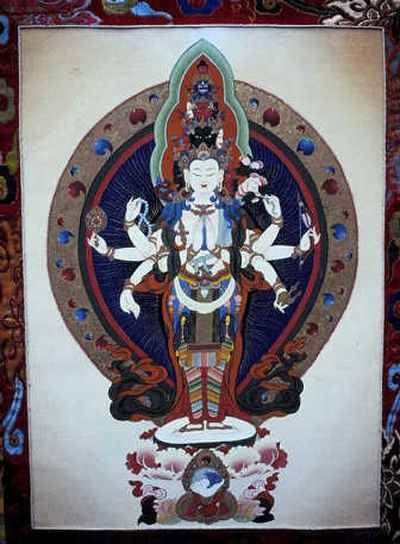Spiritual strokes

With a one-strand brush and pigments made from tree sap, dead beetles and other natural materials, Tseten Dorjee depicts the divine.
The colorful, sacred images he creates on silk or cotton canvas is known as Thangka – Tibetan Buddhist paintings that symbolize Buddhist cosmology. In addition to being an art form, Thangka is both a spiritual expression and a focus for meditation. As Dorjee and other Thangka artists embark upon the painstaking task of depicting the Buddha and other deities, they reflect not only their images, but also on the qualities that make them holy.
“They pray that the Thangkas which they create bring peace and inner harmony to whoever sees them,” said Karma Tensum, Dorjee’s friend and the executive director of the Tibetan Children’s Education Foundation in Helena.
An artist in exile from his native Tibet, Dorjee will visit Spokane on Sunday to share his latest Thangka paintings. This rare, one-day exhibit at Twist Yoga Studio will include traditional Tibetan foods as well as a screening of “Children of Tibet: The Exile Generation,” a documentary about three children who make the dangerous trip across the Himalayas to seek education and a new life in India.
The event is designed to teach people about Thangka art while bringing attention to the plight of children and others in Tibet, said Tensum, who is traveling with Dorjee. Although there is no cost to see the exhibit or documentary, a free-will offering will be taken to benefit the Tibetan Children’s Education Foundation, a nonprofit committed to the preservation of Tibetan culture (www.tibetanchildrens education.org). Founded in 1995 by Montana residents whose lives have been enriched by the culture, religion and people of Tibet, the foundation supports Tibetan schools and children-in-exile, as well as cultural exchange programs such as the work of Dorjee and other Tibetan Thangka artists.
“We want to try and preserve Tibetan culture, which is in danger of becoming extinct,” said Tensum, who grew up in India after being forced to flee his native country as a child. “Our hope is that by raising awareness here in the West, we are, in our own way, helping to preserve Tibetan culture.”
Spokane is the last stop of a three-week tour that included shows throughout Washington, Oregon and California. In 2005, the last time Thangka art was exhibited in Spokane, more than 120 people attended the three-hour exhibit, according to Anne Hanenburg, who organized both events.
“When you see Tseten’s work, your jaw just drops,” said Hanenburg, a landscape designer in Spokane. “The detail is so incredibly intricate.”
Thangka – pronounced “tong-ka” and means “flat painting” in the Tibetan language – describes the religious banners and scrolls that are traditionally displayed in monasteries and Tibetan Buddhist homes, according to Tensum. Spiritual masters and others often use them as a meditation tool, he said.
Hanenburg first learned about Thangka art during a yoga retreat in 2005. While staying at the Feathered Pipe Ranch in Helena, she witnessed several Tibetan artists who spent the day painting religious images on canvas while sitting on the floor. Even the experience of just watching them left her with a sense of tranquility, she recalled.
Hanenburg now owns one of Dorjee’s Thangkas – an 18-by-24-inch painting depicting the goddess, Tara, which she displays in her own studio.
“I am not Buddhist, but I am an art lover,” she explained. “When I view Tara, there is a true sense of peace that grounds me and brings me back into the present moment.”